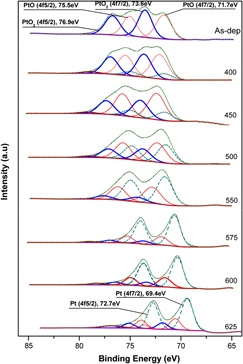Article contents
Thermal decomposition and fractal properties of sputter-deposited platinum oxide thin films
Published online by Cambridge University Press: 20 December 2011
Abstract

Porous platinum thin films were prepared by thermal decomposition at temperatures from 25 to 675 °C of platinum oxide films deposited by a pulsed reactive sputtering technique. The samples’ chemistry and structure were investigated by x-ray diffraction (XRD), x-ray photoelectron spectroscopy (XPS), and x-ray absorption near edge structure (XANES), showing that the decomposition of the oxide begins as low as 400 °C and follows a sigmoidal trend with increasing annealing temperature. In the XRD spectra, only an amorphous-like signature was observed for temperatures below 575 °C, while Pt 4f XPS showed that the deposited oxide was a mixture of PtO2 and PtO. Pt-L3 edge XANES and Pt 4f XPS spectra showed that the Pt concentration and electronic structure are predominant for temperatures equal to or above 575 °C. The morphologies of the films were investigated by the area-perimeter method from atomic force microscopy and scanning electron microscopy (SEM) images, indicating that the surfaces exhibit a combination of Euclidian and fractal characteristics. Moreover, the thermal evolution of these characteristics indicates the agglomeration of the grains in the film as observed by SEM.
- Type
- Articles
- Information
- Journal of Materials Research , Volume 27 , Issue 5: Focus Issue: Plasma and Ion-Beam Assisted Materials Processing , 14 March 2012 , pp. 829 - 836
- Copyright
- Copyright © Materials Research Society 2011
References
REFERENCES
- 12
- Cited by




